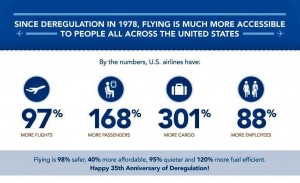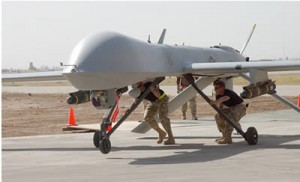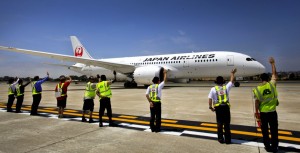35 Years of Deregulation of the Airlines
The Airline Deregulation Act of 1978 has had a tremendous impact on the airline industry over the past 35 years. Beyond the airline industry it has had a tremendous impact on countless other industries as well, most notably the tourism industry. Before deregulation flying was mostly for the elite or business travelers who could afford the exorbitant fares that existed. The relationship between the airlines and the CAB had created an excessively inflated system that made the airlines a lot of money, but also kept flying out of reach for most people.
 The transportation industry was the first major industry to deregulate starting in the early 1970s, followed eventually by the telecommunications industry, energy industry, and most recently the financial industry. All of these actions had similar goals at their heart: increased competition leading to a reduction in prices. The success of each of these industries as it relates to deregulation can be debated all day, but as it relates to the airlines, it is hard to ignore the benefits that have come from deregulation.
The transportation industry was the first major industry to deregulate starting in the early 1970s, followed eventually by the telecommunications industry, energy industry, and most recently the financial industry. All of these actions had similar goals at their heart: increased competition leading to a reduction in prices. The success of each of these industries as it relates to deregulation can be debated all day, but as it relates to the airlines, it is hard to ignore the benefits that have come from deregulation.
Taking a look at the chart on the right shows just how successful deregulation has been. Granted, you could probably make a chart that is equally convincing regarding the areas that may be seen as failures. You can even attribute some of those numbers to the natural growth of any industry, but much of that growth would not have come without deregulation.
In an article written for Businessweek, former Supreme Court Justice Stephen Breyer discussed some of the impacts of airline deregulation. Perhaps the most telling statistic he presented was this, “In 1974 the cheapest round-trip New York-Los Angeles flight (in inflation-adjusted dollars) that regulators would allow: $1,442. Today one can fly that same route for $268.”
There can be no more clear indication that airline deregulation has been successful than reading numbers like that. While it is true that ticket prices have risen recently, most of that can be blamed on two things: rising fuel prices, and the creation of TSA. One of those you can’t do much about, but the other one is, surprise surprise, more government regulation. I realize security and fare regulation are not the same thing, but it is no surprise that when the government steps in costs are bound to increase. Just look at the Affordable Care Act.
The aviation industry is as volatile as they come, and we will continue to see prices fluctuate just like any other industry. Continued energy issues along with the retirement of the baby boomers will likely have impacts that we cannot anticipate, not to mention security concerns and the introduction of more UAVs to the national airspace system. One thing is for sure though, love it or hate it airline deregulation has lowered ticket prices and made air travel a reality for a lot more people.









